The mayors of the three largest Northeast communities aren’t quite sure what to make of the premier’s musings about changing the province’s revenue sharing formula with municipalities.
Scott Moe made the comments at the Saskatchewan Urban Municipalities Association convention. The formula sees all of the province’s municipalities receive a sum equal to that generated from one per cent of the PST, shared out based on population.
“We don’t know what that means yet, to be perfectly honest,” said Rick Lang, Melfort’s mayor.
The mayor said there’s not going to be any warm and fuzzy feelings generated by changing the formula.
“That’s something that we worked on with the government for a long period of time and now it’s finally in place,” he said. “The idea that one of the two parties wants to change it is a little disturbing, to say the least.”
Lang said since municipalities have to balance their budgets, fewer dollars from the provincial government means either higher taxes, less services or a combination of both.
Rennie Harper, Nipawin’s mayor, said her understanding is there would be no changes to the formula this year, but it was on the table for future conversations.
“It is a concern, obviously,” she said. “We have a bit of a reprieve and it certainly is something that we need to, as a council, talk about because it will have an impact.”
Barry Elliott, Nipawin’s administrator, said the town was hopeful there will be stability this year, compared to the cuts the town had to absorb last year.
“It’s not where we wanted to land, but at least it hasn’t gotten worse.”
Al Jellicoe, Tisdale’s mayor, wasn’t as concerned as his Melfort and Nipawin counterparts.
“The big thing I took out of that revenue sharing is I think they’re going to still give that one per cent of the PST, it’s just a matter of what is all included in that one per cent,” he said. “Since we first made that agreement, there’s some things that have been added to the PST base, so that’s what they’ll be looking at.”
The discussion will be whether or not municipalities will benefit from the extra revenues generated due to items that now have PST added to them as a result of the March 2017 provincial budget, like children’s clothing, restaurant meals and snack foods.
Talks with ministers
The convention, held Feb. 4 to 7, was also a chance for the mayors to chat with provincial cabinet ministers.
Jellicoe talked to Warren Kaeding, the government relations minister; Jeremy Harrison, the export and trade minister, about efforts to attract new businesses to Tisdale; and Greg Ottenbreit, the rural health minister, about efforts to attract new doctors.
Harper talked to Dustin Duncan, the environment minister, about the landfill – which has been placed under the management of the regional Boreal Area Regional Waste Authority – and long-term plans in connection to enforcement of landfill regulations. She also talked to him about the need for a standard way to dispose of used needles, which can be used, for example, by those dealing with diabetes. The mayor has heard of used needles going into the recycling bin.
The Nipawin mayor also talked to Ottenbreit about communicating with the new Saskatchewan Health Authority and the need for it to establish a local community group that includes local First Nations. She also talked about the lack of housing in the town and the used needle issue. With Gordon Wyant, the education minister, she talked about the need for more spaces in pre-Kindergarten programs.
Lang talked to David Marit, the highways minister, about the province’s unfulfilled commitment to repave Saskatchewan Drive and some service roads. He reminded Ottenbreit about the promise made in 2010 to have advanced diagnostic equipment at the Melfort Hospital. He also talked to Duncan about Dutch elm disease, which is present in the area around Melfort. Around 60 per cent of municipal trees in the city are elm.
“They said all of the right stuff,” Lang said. “Hopefully they’ll do all of the right actions.”




